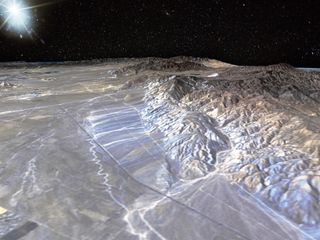This Quiet Fault in Southern California Hadn't Moved in 500 Years. Now It's Slipping.
The fault has the potential to generate massive quakes.

A series of major earthquakes shook Southern California in July and placed strain on a nearby fault that has been quiet for about 500 years, according to a new study.
And that once-quiescent fault could trigger a magnitude 7.8 temblor, the authors noted.
One plausible way for how the Ridgecrest quakes could trigger shaking on the Garlock fault, capable of a magnitude 8 quake, which could then in turn wake up the San Andreas. The chance of this actually happening is slim, but it is plausible. https://t.co/gr7ipDInwy 🗺️by @gaufre pic.twitter.com/5BJT7YmZRwOctober 17, 2019
The Garlock fault traces the northern boundary of the Mojave Desert and extends about 186 miles (300 kilometers) across Southern California. The July quakes, collectively known as the Ridgecrest earthquake sequence, rattled the earth when ruptures occurred along several small faults in the region and stopped just a few miles from Garlock. The nearby disruption triggered movement along the fault, scientists reported Oct. 17 in the journal Science. Since July, the fault has slipped about 0.8 inches (2 centimeters) at the surface.
The Ridgecrest sequence not only set the Garlock fault in motion, it has also shaken up our idea of how major earthquakes typically occur, the authors said.
"It ended up being one of the best-documented earthquake sequences in history and sheds light on how these types of events occur," study co-author Zachary Ross, an assistant professor of geophysics at Caltech, said in a statement. "It's going to force people to think hard about how we quantify seismic hazard and whether our approach to defining faults needs to change."
Related: The 10 Biggest Earthquakes in History
The most powerful shaking during the Ridgecrest sequence took place about 124 miles (200 km) north of Los Angeles, according to the statement. The event began July 4 with a magnitude 6.4 foreshock; the even-larger mainshock came about 34 hours later at a magnitude of 7.1. More than 100,000 aftershocks shook the region in the following weeks, according to the NASA Earth Observatory.
Sign up for the Live Science daily newsletter now
Get the world’s most fascinating discoveries delivered straight to your inbox.
According to the new study, the initial rupture that set off the first quake triggered a chain reaction of slips and shocks through a criss-crossing system of nearby faults. "We actually see that the magnitude-6.4 quake simultaneously broke faults at right angles to each other, which is surprising because standard models of rock friction view this as unlikely," Ross said. Twenty faults caught in the domino effect hadn't been discovered before the event, the authors reported.
The finding overturns commonly held assumptions about how major earthquakes occur, Ross said. Previously, scientists thought major earthquakes, measuring above a 7.0, were likely caused by the rupture of a single long fault and that their maximum magnitude is limited by the length of said fault. The Ridgecrest sequence exemplifies an alternate scenario: small faults can "link up" in an intricate network and set off powerful quakes, said Ross.
"Over the last century, the largest earthquakes in California have probably looked more like Ridgecrest than the 1906 San Francisco earthquake, which was along a single fault," Ross said. "It becomes an almost intractable problem to construct every possible scenario of these faults failing together — especially when you consider that the faults that ruptured during the Ridgecrest Sequence were unmapped in the first place."
- The 10 Worst U.S. Natural Disasters
- Top 11 Deadliest Natural Disasters in History
- 10 Amazing Facts About the 1964 Alaska Earthquake
Originally published on Live Science.

Nicoletta Lanese is the health channel editor at Live Science and was previously a news editor and staff writer at the site. She holds a graduate certificate in science communication from UC Santa Cruz and degrees in neuroscience and dance from the University of Florida. Her work has appeared in The Scientist, Science News, the Mercury News, Mongabay and Stanford Medicine Magazine, among other outlets. Based in NYC, she also remains heavily involved in dance and performs in local choreographers' work.
Most Popular


